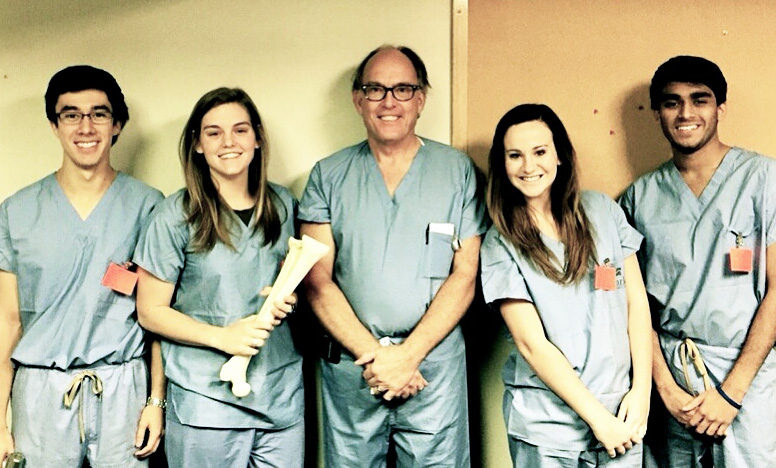Biomedical Engineering Students Visit Sparks Medical Regional Center

U of A students Jonathan Stone, Bethany Knight, Jordan Rose, and Kunal Shah stand with Dr. John Harp, an orthopedic surgeon at Sparks Regional Medical Center.
On Sunday, Nov. 8, four students from the University of Arkansas Biomedical Engineering Department traveled to the Sparks Regional Medical Center in Fort Smith for a two-day trip. Under the guidance of Dr. John Harp, an orthopedic surgeon at Sparks, U of A students Jonathan Stone, Bethany Knight, Jordan Rose and Kunal Shah had the chance to shadow several members of the Sparks Orthopedic team and sit in on a number of surgeries, including three knee replacements, a hip replacement, and a shoulder replacement.
The impetus for the trip came from a Senior Design class the students are enrolled in — a required course for all seniors in the Biomedical Engineering Department. In the course, Stone, Knight, Rose and Shah have been working to create a device that monitors airborne bacteria in operating rooms as a way of helping to prevent surgical site infections.
While they've been making strides developing the monitors in class, Harp suggested that it might be beneficial for the students to witness firsthand the environment they were designing for, and, as such, suggested the trip to Sparks. Specifically, Stone explained, Harp wanted the students to see which parts of an operating room they could sample for bacteria. As Shah puts it, "That's the motivation for the project: to quantify the sterility [of the operating room]."
In an interview following the trip, Stone described how a series of open agar plates were located around the operating rooms he witnessed, which enabled him to see exactly how much material finds its way into the air during a typical orthopedic surgery. This interference material, he explained, includes not only blood and bone dust, but also fumes from cauterized flesh. Additionally, Stone noted, the airflow in the room is important. In the surgeries he observed, there were six downward-pointing vents around the operating table, which resulted in a very distinct series of air traffic patterns.
When asked what stuck with them after the trip, both Stone and Shah mentioned the measures the surgeons themselves took to keep surgical site infections at a minimum. During operations, they observed, surgeons like Harp are covered in heavy duty "astronaut suits" and face shields, which produce air that allows them to breathe easily inside the suits. While such measures may seem extreme, Shah explained that they're a vital part of any sterile surgical environment.
Stone and Shah also highlighted the kindness of Harp as an aspect of the trip they'll remember. They had the chance to have dinner with the surgeon after their first day at Sparks, and over the course of the meal were impressed by his generosity and willingness to work with students. Said Stone, "I appreciated what Dr. Harp told us—that he's glad he's gone through enough schooling to be able to give back now as a teacher."
Ultimately, however, Stone maintained that his favorite part of the trip to Sparks was being in the operating room itself. Hearing his enthusiastic description of the surgeries he witnessed, it's easy to see why. Recalled Stone, grinning, "I definitely got some blood spattered on me. They allowed us to get really close—not to a point where it would compromise the surgery—but close. About a yard away from the action."
Contacts
Elizabeth DeMeo, media specialist
Biomedical Engineering
603-548-3989,
eademeo@uark.edu